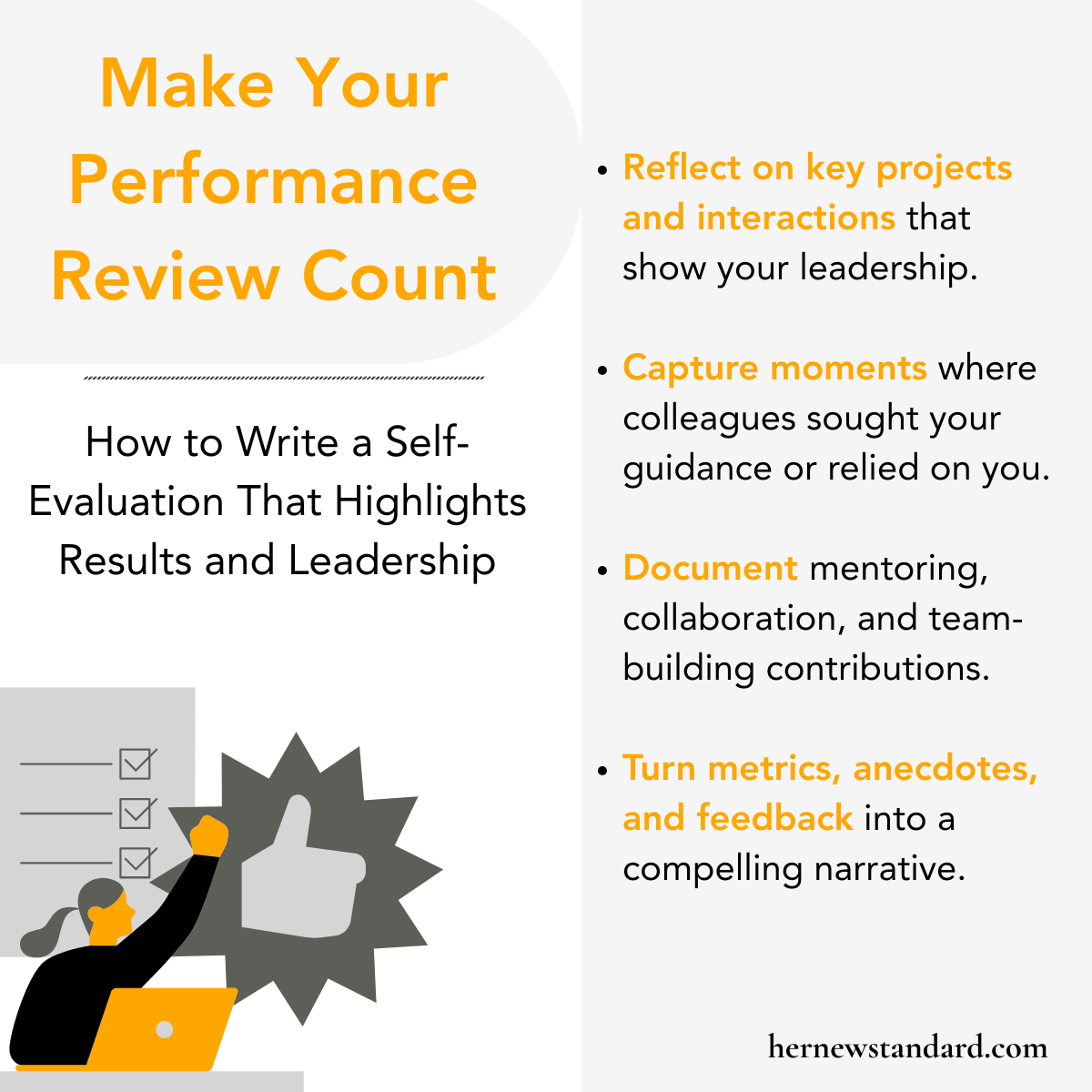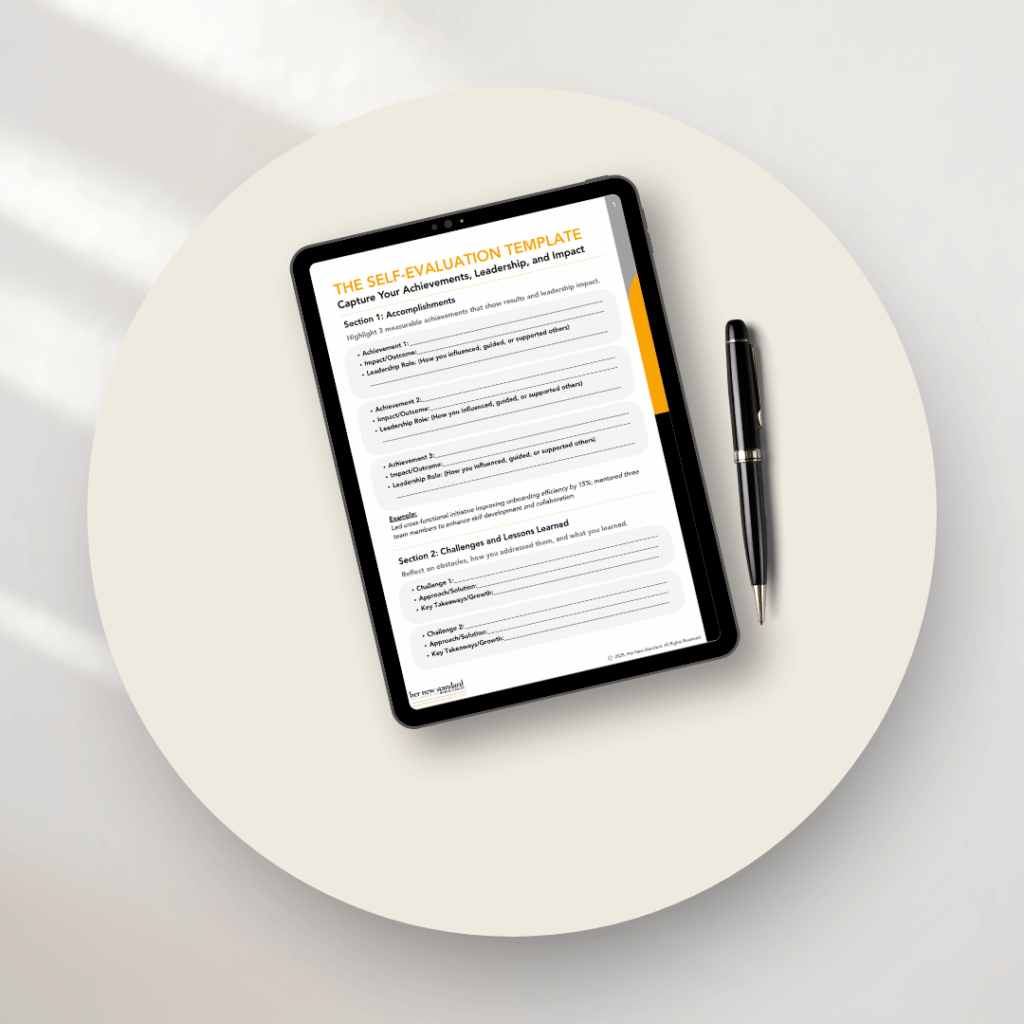TABLE OF CONTENTS
The Year-End Balancing Act
As the calendar year closes, leaders are often asked to do two things simultaneously: assess their own performance and evaluate their teams. The self-evaluation becomes a critical part of their final review, so it’s an opportunity leaders should capitalize on.
However, it’s a delicate juggling act, and for women leaders, there’s often an added layer of complexity. Much of the work that women contribute, such as mentoring colleagues and fostering team cohesion, is frequently invisible in traditional performance metrics. If it’s not documented and highlighted, it may never be recognized.
In one of our leadership programs, a senior director at a global company realized during her executive coaching sessions that her self-evaluations had always focused solely on results. She could rattle off metrics, project milestones, and deliverables with precision. But when asked how she had led her team to achieve those results, she paused. She worked with her coach to reframe her narrative to include how she developed her team’s confidence, created space for collaboration, and helped a rising manager step into new responsibilities.
When she presented that version of her self-evaluation, her manager understood her contribution at a whole different level.
That’s the power of a well-crafted self-evaluation. While quantified results are critical to include, as that’s how success is often judged, it’s also important to name the influence, growth, and leadership that got you there. It’s your chance to reflect, celebrate wins, acknowledge learning, and communicate your full impact on your own terms.
In this article, we’ll walk through how to write a self-evaluation that captures your full leadership story with practical frameworks, real examples, and a template you can use to make this year’s review your most powerful yet.
Key Takeaways
- A self-evaluation is your chance to own the narrative and define your impact before anyone else does.
- Many women leaders minimize the mentoring, problem-solving, and team building that truly drive results.
- The strongest reviews connect outcomes to leadership — showing not just what you delivered, but how you delivered it.
- A well-crafted self-evaluation doesn’t just summarize your year — it signals readiness for what’s next.
Understanding Self-Evaluation Performance Reviews
At its core, a self-evaluation performance review is a tool for reflection, communication, and strategic visibility. It allows you to present not just what you accomplished, but how you led, influenced, and contributed to the broader success of your team and organization.
Women’s contributions are often underestimated in traditional review processes. Research shows that:
Documenting these contributions in your self-evaluation ensures your full impact is recognized and valued.
When written with intention, your self-evaluation connects what you delivered to how you led. It reveals the mindset, influence, and growth that define your impact.
Before You Begin: How to Prepare
Investing time upfront ensures your self-evaluation tells the full story of your leadership. One way to gather insight into your impact is to reflect on specific projects, interactions, and outcomes, and consider moments where others expressed appreciation, sought your guidance, or relied on your expertise. Reviewing emails, project notes, or feedback from past meetings can also reveal patterns of influence and contribution.
Then, create a list of accomplishments and moments where you demonstrated leadership, not just in what you achieved, but in how you contributed to the team’s success. Along with quantifying the data that proves your success, capture examples of mentoring, collaboration, and ways you strengthened team culture or helped others grow. These contributions often shape performance more than any single project milestone, and documenting them ensures your full value is visible.
Think of your preparation as building a narrative. Each bullet, metric, and anecdote tells a story of influence, growth, and leadership that supports your professional trajectory.
Benefits of Self-Evaluations
A self-evaluation lets you frame your impact before anyone else does. Think of it as an executive summary of your year: what you led, how you led, and the ripple effects of that leadership.
At Her New Standard, women we coach often say, “I didn’t realize how much I’d accomplished until I wrote it down.” Managers agree: self-evaluations surface strengths and contributions that day-to-day work can obscure. The process highlights leadership behaviors that help teams thrive and not just tasks completed.
Too often, women underestimate the power of putting their impact into words. Work that builds culture, develops others, and strengthens collaboration rarely appears on a spreadsheet. A self-evaluation gives you the space to name it clearly, confidently, and on your own terms.
A strong self-evaluation helps you:
- Make your impact visible. Connect outcomes to the leadership required to achieve them.
- Reinforce your presence. Show how you led through challenges with strategy and composure.
- Drive meaningful conversations. Owning your story turns a review into a dialogue about growth and vision.
- Model intentional leadership. Demonstrating reflection sets the tone: growth is something you lead.
Done well, a self-evaluation is a statement of who you are as a leader—showing value metrics alone can’t capture. Research confirms that women who clearly communicate their achievements, leadership, and influence gain recognition, advance faster, and earn more.
Writing a Self-Evaluation Performance Review
Now that you’ve reflected on your year and recognized the impact you’ve made, it’s time to get started on writing your review. This is where reflection meets strategy: a chance to translate your accomplishments, growth, and leadership into a narrative that guides your conversation with your manager. Focusing on achievements, challenges, influence, and future goals helps you create a self-evaluation that’s both clear and compelling.
- Accomplishments: Highlight measurable results, emphasizing both individual achievements and team contributions.
- Challenges and Lessons Learned: Show resilience, adaptability, and how you converted obstacles into learning opportunities.
- Leadership and Influence: Include mentoring, team development, DEI efforts, and any cultural impact.
- Goals for the Future: Connect your achievements to next year’s objectives and organizational priorities.

Self-Evaluation Examples
Seeing examples can make writing your own self-evaluation much easier. Here are ways to frame your contributions, highlighting both achievements and growth:
Achievement-Focused – Emphasize measurable results and tangible outcomes:
- “Led two cross-functional initiatives that improved onboarding efficiency by 15% and mentored three team members, enhancing both process and skill development.”
- “Launched a new client reporting system that reduced errors by 20% and increased team satisfaction with the process.”
- “Secured three strategic partnerships that expanded our market reach and contributed $500K in revenue.”
Growth-Focused – Highlight development, learning, and how you’ve elevated others:
- “Prioritized delegation to empower team members, allowing me to focus on strategic priorities while building their confidence and ownership.”
- “Took on a high-profile project outside my comfort zone, improving my presentation skills and gaining cross-departmental visibility.”
- “Implemented regular feedback sessions with my team, which improved collaboration and helped identify future leaders.”
These examples show how to capture both results and leadership impact, giving your self-evaluation depth beyond daily tasks.
Self-Evaluation Template
Once you’ve seen examples, it’s helpful to have a clear structure to guide your writing. Using a template ensures you cover all the key areas while keeping your review concise and impactful. To make it even easier, we’ve created a downloadable self-evaluation template PDF you can fill out directly.

Self Evaluation for Performance Review Template
Struggling to capture the full scope of your work and leadership in your self-evaluation? This guided template helps you translate a year’s worth of accomplishments, influence, and growth into a clear, compelling narrative.
(No email required)
Self-Evaluation for Performance Review Questions
Once you’ve reflected on your accomplishments and challenges, these guiding questions can help you dig deeper and articulate your impact clearly. Think of them as prompts to uncover both measurable results and the leadership behaviors behind them.
- Which achievement are you most proud of?
Reflect on results that had meaningful impact on the team, organization, or stakeholders. - How did you demonstrate leadership and influence?
Consider how you inspired, guided, or supported others, even in informal ways. - What feedback helped you grow?
Identify key insights from peers, managers, or direct reports that shaped your development. - How did you contribute to inclusion and team culture?
Highlight efforts to foster belonging, support diverse perspectives, and strengthen collaboration. - What obstacles did you overcome, and what did you learn?
Demonstrate resilience, adaptability, and problem-solving. - Where did you enable others to succeed?
Showcase mentorship, delegation, or initiatives that developed team capabilities. - Which moments best reflect your values or leadership philosophy?
Connect your actions to the principles you bring to your work every day. - How can you make an even bigger impact next year?
Use this to set intentions and tie your accomplishments to future goals. - Which goals will challenge you next year?
Think about what will stretch your skills, expand your influence, or elevate your role.
Performance Review Tips for Managers
As you turn the tables and review the self-evaluations of your direct reports, remember this is your chance for a strategic development conversation. Beyond reviewing accomplishments, treat them as a coaching tool, an opportunity to understand not just what your team delivered, but how they led, influenced, and shaped their teams.
Stanford research shows gender bias can influence ratings, with women often held to higher standards. Take-charge behaviors that are rewarded in men may face scrutiny or backlash in women. Structured, thoughtful review conversations counteract this by focusing recognition on concrete performance and leadership impact, not subjective impressions.
To maximize self-evaluations:
- Ask clarifying questions. Let employees explain their leadership and impact in their own words.
- Look beyond metrics. Recognize contributions that strengthen team culture, mentor colleagues, or drive cross-functional influence.
- Provide actionable feedback. Tie accomplishments to growth opportunities and future goals.
- Check for bias. Ensure evaluations are consistent across gender, role, and other factors.
When approached as a collaborative conversation, self-evaluations become a tool for growth, stronger leadership, and fair recognition.
Common Mistakes to Avoid in Your Self-Assessment
Even the strongest leaders can undercut their own impact if their self-evaluations aren’t strategic. Women, in particular, often fall into patterns that reduce visibility and recognition:
- Downplaying achievements. Minimizing wins or framing successes as “team efforts only” can obscure your leadership.
- Using vague language. Ambiguous phrases like “supported projects” or “helped the team” don’t convey measurable impact. Metrics, outcomes, and concrete results give your evaluation weight.
- Omitting leadership influence. Mentorship, team development, and efforts that strengthen culture or collaboration often go unrecognized if not explicitly called out.
A self-evaluation that names both results and the leadership behind them ensures your influence is visible, respected, and rewarded.
Connecting Self-Evaluations for Performance Reviews to Future Goals
A self-evaluation is your roadmap forward. Use it to define not only what you want to achieve next year, but how you’ll grow as a leader while advancing goals for your team and organization.
Start by identifying the skills you want to strengthen and the leadership behaviors you want to stretch. Are there projects where you can take more ownership, step into cross-functional leadership, or tackle a challenge that pushes you beyond your comfort zone? Your self-assessment is the place to name these opportunities and make a case for yourself. Of course, it can be tricky to both claim credit for what you accomplished and also acknowledge where you need to grow. If you’re advocating for a salary increase or promotion, you may want to have this future-focused conversation separately.
Think about visibility and advocacy. How can you ensure your contributions are recognized by decision-makers? Which relationships or mentors can help you achieve these goals? A strong self-evaluation helps position you strategically, signaling where you’re headed and why it matters.
Finally, connect your future goals to tangible business impact. Whether it’s improving team efficiency, strengthening collaboration, or elevating others through mentorship, tie your growth plan to measurable outcomes. This is where self-reflection transforms into strategy and shows not just what you’ve done, but where you’re going and the leadership footprint you intend to leave.
Self-Evaluation for Performance Review Tips and Strategies
- Start early and collect feedback
- Highlight measurable results
- Include leadership influence, mentoring, and team impact
- Revisit mid-year to track progress and update your narrative
Ready to Turn Reflection Into Real Growth?
FAQ: Writing a Self-Evaluation for Your Performance Review
Q: What should I include in a self-evaluation for a performance review?
A: Cover your measurable accomplishments, leadership contributions, team impact, problem-solving and growth moments, and future goals. Highlight not just what you delivered, but how you led, influenced, and shaped outcomes.
Q: How long should a self-evaluation for a performance review be?
A: Aim for 1–2 pages. Concise and focused is better than lengthy. Each section should be impactful and evidence-based.
Q: What format works best for a self-evaluation for a performance review?
A: Use structured sections:
- Accomplishments: 3–5 measurable highlights.
- Challenges and Lessons Learned: Show resilience and learning.
- Leadership and Collaboration: Include mentoring, team influence, and cross-functional impact.
- Goals for Next Year: Connect past successes to future growth.
Q: How do I make my leadership visible?
A: Frame examples to show influence, not just outputs. Highlight moments where you coached, built consensus, elevated others, or navigated challenges with strategic insight.
Q: How can I link this year’s performance review to next year’s growth?
A: Identify skills to strengthen, opportunities to increase visibility, and projects that align with your career goals. A strong self-evaluation connects past accomplishments to future aspirations.
Q: What common self-evaluation mistakes should I avoid in my performance review?
A: Avoid downplaying your achievements, using vague language, or leaving out contributions to team success and culture. Make sure your evaluation tells the full story of your influence.
Enjoyed this post? You might also like…




